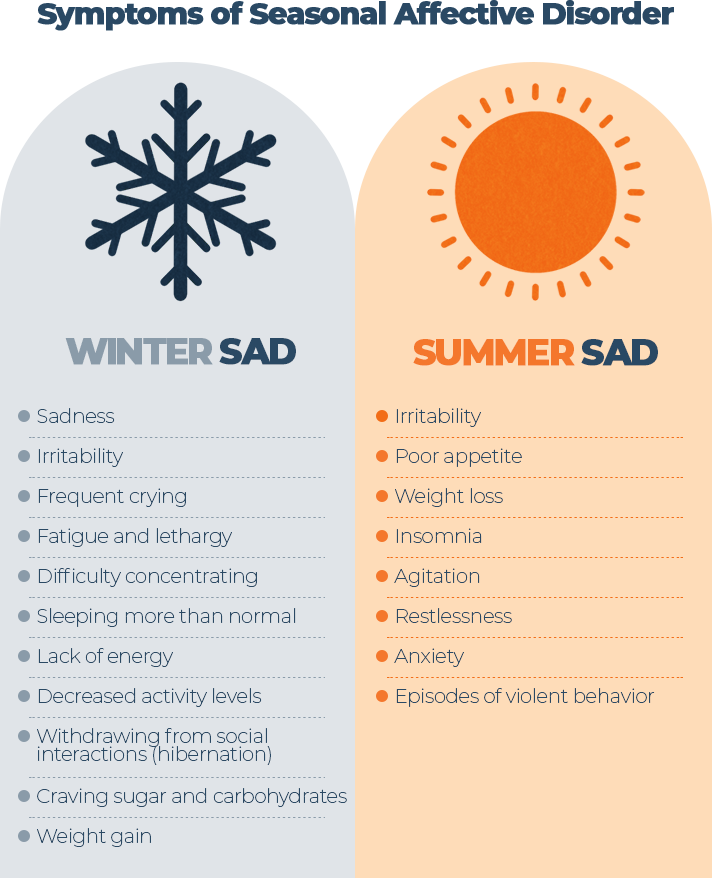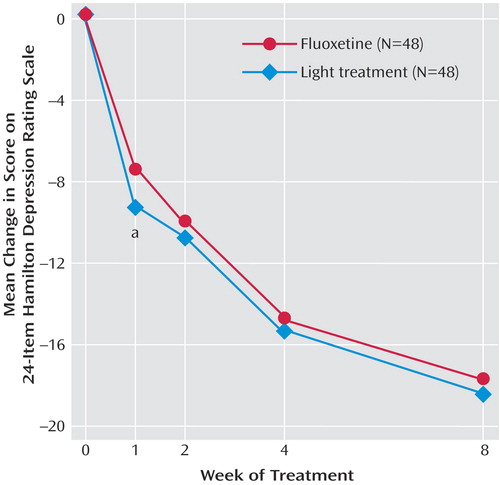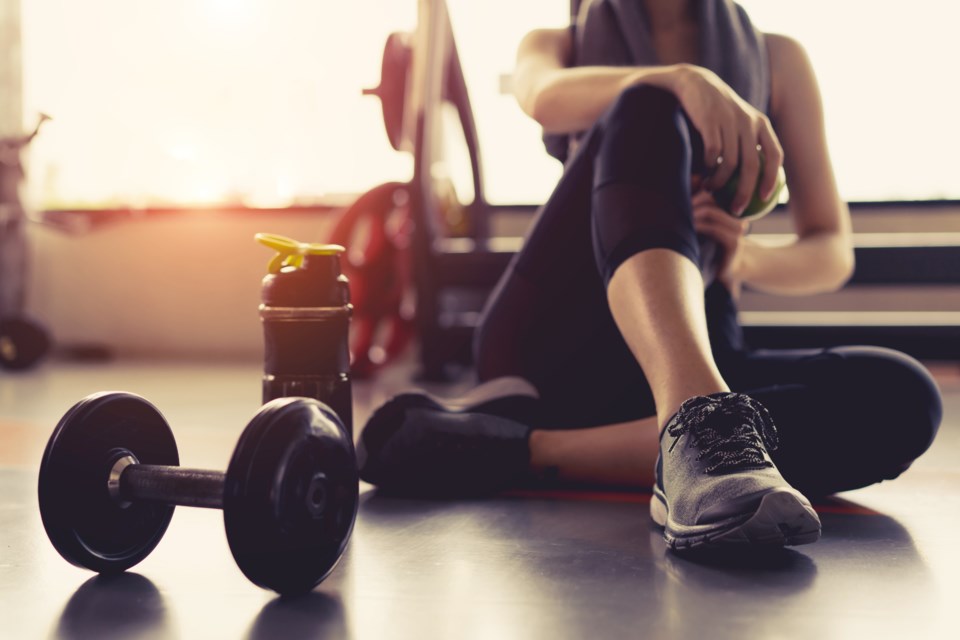Combat Seasonal Affective Disorder with These Tips

It's that time of the year... weather getting colder, nights getting longer, and energy levels dropping.
If you notice your overall mood, energy, and motivation changing with the season, you may be experiencing seasonal affective disorder (SAD).
What is Seasonal Affective Disorder (SAD)?
According to the Mayo Clinic, Seasonal affective disorder (SAD) is a type of depression related to changes in seasons — SAD begins and ends at about the same times every year. For most, symptoms of SAD begin in the fall and continue on through the winter months. Less commonly, some find that their symptoms show up during the spring and summertime.
Symptoms of SAD include
- Feeling listless, sad, or down most of the day, nearly every day
- Losing interest in activities you once enjoyed
- Having low energy and feeling sluggish
- Having problems with sleeping too much
- Experiencing carbohydrate cravings, overeating, and weight gain
- Having difficulty concentrating
- Feeling hopeless, worthless or guilty
- Having thoughts of not wanting to live
Winter-Onset SAD vs. Summer-Onset SAD
Symptoms specific to winter-onset SAD, sometimes called winter depression, may include: oversleeping, appetite changes, especially a craving for foods high in carbohydrates, weight gain, and tiredness or low energy.
Symptoms specific to summer-onset seasonal affective disorder, sometimes called summer depression, may include trouble sleeping (insomnia), poor appetite, weight loss, agitation or anxiety, and increased irritability.

SAD Risk Factors
There are some people who are more at risk for SAD than others. For example, seasonal affective disorder is four times more likely in women than in men. Other groups who are higher at risk are young adults, those with clinical depression and/or bipolar disorder, and those with a family history of SAD. Additionally, people who live further from the equator are also at a higher risk for experiencing SAD due to longer, and colder, winters (leading to decreased levels of vitamin D).
Causes of SAD
Although the exact cause of seasonal affective disorder is not yet known, there are a few key factors that can come into play.
- Disruption in your biological clock (circadian rhythm). As the days get shorter, you are exposed to less and less sunlight throughout the fall and winter. This decrease in sunlight may disrupt your body's internal clock and lead to feelings of depression.
![]()
- A drop in serotonin levels. Serotonin is a chemical in the brain chemical that affects mood. Reduced sunlight can cause a drop in serotonin which may trigger depression.
- An increase in melatonin levels. During the winter months, some people produce amounts of melatonin that are higher than normal, resulting in SAD symptoms such as sleepiness and low energy levels.
Symptom Management
Although we cannot force the sun to stay out longer or keep the air warm, we can take action to combat the symptoms of SAD. Here are tips to feel like your best self this fall and winter.
#1 Light Therapy
In a study called The Can-SAD Study: A Randomized Controlled Trial of the Effectiveness of Light Therapy and Fluoxetine in Patients With Winter Seasonal Affective Disorder, participants were subject to a double-blind treatment to study the effectiveness of light therapy vs a common anti-depressant, Fluoxetine in reducing the symptoms of seasonal affective disorder over 8 weeks. The results are impressive, light therapy was shown to be just as effective as the anti-depressant.

Figure 2. Change in 24-Item Hamilton Depression Rating Scale Scores in Patients With Seasonal Affective Disorder Randomly Assigned to 8 Weeks of Double-Blind Treatment With Light Therapy Plus Placebo Capsules or Fluoxetine Plus Placebo Light
How to Practice Light Therapy
In the study above, participants were exposed to white fluorescent light for 30 minutes as soon as possible upon waking. There are many options available on the market today. A simple amazon search will pull up ample options, like this one. You can also invest in a light therapy alarm clock (I have this one right next to my bed!) that will mimic the rising and setting of the sun to aid in regulating your circadian rhythm to make it easier to wake up in the morning and fall asleep at night.
#2 Prioritize Self Care
The term "self-care" gets thrown around a lot these days. While everyone's version of self-care looks a little different, there is usually some form of exercise, ways to de-stress and de-compress, and healthy eating practices involved. Here are some ways to prioritize your health and wellness this fall and winter.
Start a New Weight Training Program

Have you ever noticed that after an exercise, such as going for a walk or taking a yoga class, you are in a much better mood? The same thing applies to weightlifting.
A study titled Association of Efficacy of Resistance Exercise Training With Depressive Symptoms, did a meta-analysis of 33 clinical trials including 1877 participants, to see whether resistance exercise training was associated with a significant reduction in depressive symptoms. The evidence supports resistance exercise training as an alternative and/or adjuvant therapy for depressive symptoms.
So, if you are already putting in work at the gym, keep it going!! If you aren't, now is a great time to start.
Need guidance? We have various 6-Week Training Plans that you can follow along in our private training app, with the ability to watch videos of each movement and track progress over time. It's perfect for those in need of a fresh routine or some additional accountability!
De-Stress and De-Compress
There are many ways to de-stress and de-compress. One of my favorite ways to de-stress is a warm bath. If you are a bath fanatic like me, I suggest you try the Flewd bath bomb, the first-ever bath treatment to help naturally combat SAD by refueling our bodies with overwhelm-relieving nutrients like Magnesium, Vitamins B3, and B6. Here are some other ways to unwind.
- Journal (gratitude, brain dump to clear your mind, organize tasks for the day, etc.)
- Drink a warm drink (tea, anyone?)
- Arts & crafts
- Take a bath
- Listen to your favorite music
- Call a friend
- Get some fresh air
Fuel Your Body With Nutritious Foods
When working to improve your overall health, eating a healthy diet can be one of the biggest challenges, especially when faced with the additional symptoms of SAD. When our serotonin levels are low and we are tired from not getting proper sleep, our bodies will crave junk food more than they normally would. Junk food is typically higher in calories (and sugar) which will give our bodies that quick boost of energy it needs. Sounds great, right? It does, until you factor in the equally as quick drop in energy (a.k.a. the sugar crash) that you will get from eating processed foods.
In addition to the highs and lows of energy that junk foods are likely to cause, they also do not provide much nutritional value. It is important to consume foods that will digest at a rate to keep you satiated while also being sure to eat foods that will give you the nutrients you need to be energized and healthy.
In a study titled Dietary patterns and depression risk: A meta-analysis, they concluded that "a dietary pattern characterized by a high intake of fruit, vegetables, whole grain, fish, olive oil, low-fat dairy and antioxidants and low intakes of animal foods was apparently associated with a decreased risk of depression. A dietary pattern characterized by high consumption of red and/or processed meat, refined grains, sweets, high-fat dairy products, butter, potatoes and high-fat gravy, and low intakes of fruits and vegetables is associated with an increased risk of depression."
So what do you do to make sure your diet is combatting your depression symptoms, not contributing to them?
Eat a balanced diet of whole foods, meats, vegetables, fruits, and fiber. Of course, it's okay to have some "fun" foods here and there, as long as your food intake consists primarily of good-for-you foods.
Not sure where to start? I recommend getting to your what your intake looks like by tracking your macros. You will be amazed at what you learn about the food you eat every day! Download our FREE Macro Cheat Sheet to get yourself started. If you're ready to take it to the next level, setting a macro goal for yourself is your next best move! Need total assistance? Our VIP Program provides clients with a custom meal plan and macros to ensure they are successful.
#3 Vitamins and Supplements
If you are eating a diet comprised primarily of healthy, whole foods, you shouldn't have to rely too heavily on vitamins and supplements. Supplements should be, as their name suggests, supplemental to your diet (not an excuse to neglect eating nutritious foods). However, there are times of the year when you may want to boost your vitamin/supplement intake to offset seasonal factors. For example, during the fall and winter months, exposure to natural sunlight decreases, which can lead to a reduced intake of Vitamin D. It's during this time of the year that many recommend supplementing with Vitamin D. Here are some recommended vitamins and supplements that can help counter the symptoms of SAD.
- Vitamin D - A fat-soluble vitamin that is naturally occurring in a few foods but is primarily produced by exposure to sunlight. Vitamin D is vital for healthy bones and muscles, and for brain and respiratory function.
- 5-HTP - The intermediate metabolite between the amino acid L-tryptophan and serotonin. 5-HTP supports the production of serotonin in the brain and central nervous system; serotonin can impact sleep, mood, appetite, and body temperature.
- SAM-e - Aids in enhancing your mood, promotes joint health and helps support detoxification and overall healthy liver functions. SAM-e can reduce the onset of panic attacks, depression, and anxiety with consistent use.
- MasterBrian AM & PM Stack - Beat the morning grogginess, stay alert during the day, and sleep like a baby. Increase memory and concentration, heighten mental acuity & problem solving, optimize brain function and health, assist in achieving optimal REM sleep, and promote cognitive recharge and recovery.
- Greens & Multi-Vitamins - A good year-round go-to. This stack delivers key nutrients, in proper amounts, so that you can power through even the toughest days.
Want to understand how I use macro tracking to eat intuitively while staying in shape? Get the macro cheat sheet guide.
I worked with my team to put together a quick list of some of the most common foods so you are able to reference this as you are focused on maintaining a healthy lifestyle. Simple. Easy. Effective.
